This guide to Corfu will help you plan your island-hopping adventure to this iconic island of verdant hills and azure seas, right at the end of the Adriatic Sea.
Known as Kérkyra to the ancients and as a sun-splashed, lush, and rugged land to travellers today, Corfu is one of Greece's timeless beauties. It straddles the Adriatic and Ionian seas in the far north-western corner of the country, unfolding in a patchwork of soaring peaks that rise to nearly 1,000 metres up and olive-covered coastlands punctuated by boat-bobbing coves. Corfu might be more built up than in the days when it was the muse to romantic writers and poets, but that means the isle can offer the best of both worlds: Buzzy resort towns and empty coves or rustic hamlets in the hills.
Tempted? Of course you are! This guide to Corfu will run through all you need to know about the island, from the best time to visit to the top beaches and things to do. Let's begin…
Where is Corfu, Exactly?
Corfu doglegs through the end of the Adriatic Sea into the top of the Ionian Sea. It's Greece's northwesternmost major island, a place closer to Italy than to Athens (the tip of Puglia is about 65 miles west). The port of Igoumenitsa is the nearest departure point on the mainland, and where most of the ferries to Corfu will leave from. The far north-eastern side of Corfu comes super close to Albania, with a strait that's a mere 1.5 miles at its narrowest point separating the two.
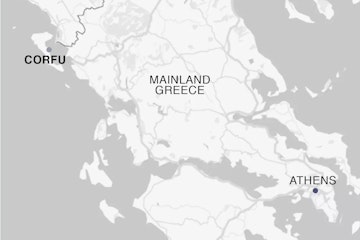
Corfu is one of the northernmost of the Greek islands. That means the weather here is more temperate than in, say, Crete. Don't worry – it still gets hot, especially in the summer months. What's more, it's common for balmy days to linger on well into October. Winter will see more rain than other islands, but that helps give Corfu it's green interior and wooded backcountry, so it's not all bad. Overall, we'd say anytime between May and September is the best time to visit.
When to Visit Corfu
Corfu in Winter
Average highs hit 15 C, with lows of around 7 C, in December on Corfu. On top of that, around a third of the month has rainfall, which means that this isn't the best time to hit the island if you're keen on lazing on the famous beaches of Kassiopi and Palaiokastritsa. On the flip side, hotel rates drop immensely and there's hardly anyone else about, so winter could be perfect if you're heading to enjoy the culture of the mountain villages and the history of Corfu Town.
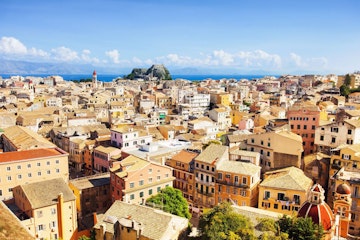
Corfu in Spring
When April swings around, Corfu gets pretty darn stunning. Daily highs regularly touch 20 C, and by May that's up to a whopping 23 C, with up to nine hours of continuous sun to boot. The mountains and central valleys are looking stunning at this time of year, as well as the olive groves and pine woods glowing green following heightened winter rainfall. That's why we usually recommend spring as the best time for hiking in Corfu.
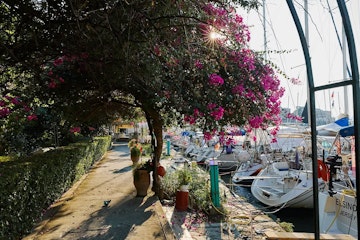
Corfu in Summer
Pack the sunnies and the sun cream, Corfu in the summer is a scorcher. Yes, this might be one of the northern isles of Greece, but the thermometers regularly clock to well over 30 C between June and August. There also tends to be less-strong cross winds coming over Corfu than across the Cyclades chain, so there's little to temper the heat. Summertime is – naturally – the busiest season of all, so there will be booming crowds in major resorts like Messonghi and Kavos.
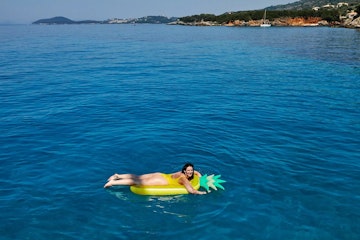
Corfu in Autumn
Autumn is one of the best times of the year on Corfu. Lingering summer warmth persists into October, allowing for regular daytime temperatures in the mid-20s. Sea temperatures also stay pleasantly high, also sticking around the 20s (perfect for swimming if you ask us!). But there's also the added bonus of diminishing crowds, as the partiers depart Kavos and the families leave Gouvia and the east coast. Expect good bargains on hotels, although some tavernas might shut up shop by early November.

Things to Do in Corfu
One of the great things about Corfu is that it offers something for just about any type of traveller (okay, maybe not snow-hungry skiers). There are family-friendly resorts next to remote coves, high mountains dropping to eco olive farms, foodie tavernas and more history than you can shake a bottle of highland honey at. Let's take a look…
Get Lost in Corfu Town
Home to both Corfu Airport and the main ferry port, Corfu Town is likely to be most travellers' first stop on this lovely island. It's a great way to begin, because the place oozes heritage and culture. Yep, there are layers of Byzantine and Roman history, Italian and Norman architecture. Head to the duo of fortresses that flank the core of the city to uncover tales of the Venetian trading empire. Then, delve into the centre to get lost in a maze of lanes and plazas that burst with fruit shops, honey sellers, cafés and tavernas.
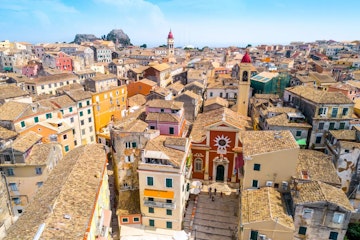
Explore Agni Bay
Bijou Agni Bay sits in a small opening on the eastern shoreline of Corfu. We'd say it pretty much sums up the island's vibes. Once sleepy, but now bustling with local life, it's home to the fantastic Nikolas Taverna (where they get the seafood straight off the boats at the nearby jetties each morning) and a handful of dive schools. The swimming isn't great because it's rocky, but you can rent a boat and head out to explore the surrounding coves at your own pace.

Go Monastery Hopping
Corfu's rich cultural past means that it's dotted with some fascinating landmarks. Start with the Vlacherna Monastery. Perched on its own little islet to the south of Corfu Town, it has origins in the 17th century and makes for one seriously stunning photo op with the Greek mainland rising in the distance behind. Paleokastritsa Monastery is also amazing. It crowns a forested hill on the west coast, where it opens into an enthralling museum of Byzantine art and has a tale to tell that begins all the way back in the 1200s AD!

Party in Kavos
Kavos is the hedonistic hub of the whole Ionian Islands. It's the town that this part of Greece offers in the face of Ios and Kos over in the Aegean. It's also off the hook. Kavos Strip – a 700-meter-long dash of bars and clubs – is where the action is at. There, you'll find R&B dancefloors at Snobs Bar and huge laser shows with world-class DJs going down at Future. In the day, hit Kavos beach to sunbathe and swim off the hangover!

Hiking – It's Endless on Corfu!
Pack the walking boots for your trip to this corner of Greece, because no guide to Corfu could skip the enticing backcountry and its hiking opportunities. It ranges from the soaring peak of Mount Pantokrator (906 metres, no less) up north, to the wooded valleys of the central highlands. There are plenty of spectacular paths to conquer, not least of all the coastal lookouts of Cape Drastis and the long-distance Corfu Trail, which is 174km of coast-to-coast adventure. Check out the Corfu & Albania Explorer - a 7 day hiking adventure through Greece and Albania that starts and ends in Corfu.
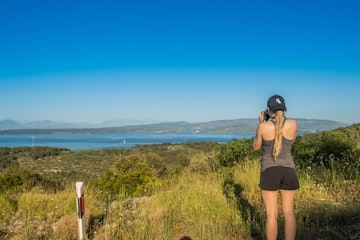
The Best Beaches in Corfu
There are far too many fantastic beaches to choose from here – some estimations count over 55 individual coves and sand stretches. That's why we've focused on just five for this guide to Corfu, ranging from the rocky bays of the eastern coast to the long and cliff-backed sand stretches of the west.
Palaiokastritsa
Probably the most famous Corfiot beach of all, Palaiokastritsa is thought to have been the spot that tempted Odysseus onto the shores of the island during his long quest to return home. It's certainly a stunner, with a series of horseshoe inlets divvied up by bulging limestone rocks. In all, there are six separate beaches in Palaiokastritsa, all woven together by undulating walking tracks through packs of gnarled olive trees. Come for a day and you're likely to stay a week. You've been warned.
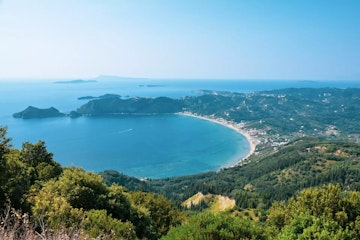
Glyfada Beach
More than anything, Glyfada beach is known for its square meterage. Stretching for a whole kilometre along the western shore of the island, just a stone's throw down the hillsides from Pelekas town, you can come here when it's time to escape the crowds of sunbathers. A Blue Flag rating means the water is super clean and clear. Plus, the sunsets are something special – hang around until evening to catch them, perhaps with a cold beer courtesy of one of the on-sand taverna bars.
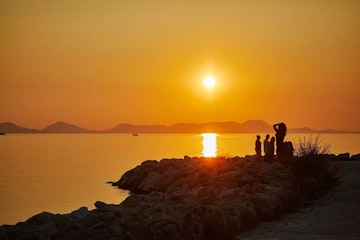
Rovinia Beach
The arias and myrtle trees cluster on the headlands just above the gorgeous arc of pebble sand that is Rovinia Beach, located some 35 minutes' drive from Corfu Town. They frame the scene to the back, while huge marble cliffs glimmer and shine behind spear-like pine trees to the north. Being out on the western coast of Corfu means Rovinia has a stony seabed. That helps to increase underwater visibility and keep the Ionian Sea shimmering in a pure turquoise blue whenever the sun shines (as it usually does!).

Kerasia Beach
It takes around an hour to drive from Corfu Town to Kerasia up on the northeast shoreline. What a journey it is, though! You'll wiggle and wind on meandering coast roads that bend through olive farms and creep up to lookout points where you can view Albania across the strait. The culmination of it all is Kerasia Beach, which has pebbles and tavernas aplenty. It's beset by two high hills that are marked out with slender Mediterranean cypresses and is rarely as busy as nearby Kassiopi.

Sidari's Kanali Tou Erota
The Canal d'Amour (Kanali tou Erota in Greek) of Sidari is one of the most striking beaches on the island. No guide to Corfu could miss it, because it's pretty darn unique, offering high walls of layered stone where sunbathers bake in the warmer months, all cut through by a narrow channel of perfectly azure Adriatic water. Check out the Kahlua Clifftop Restaurant, where you can devour deep-fried sardines and gyros while gazing at the view.
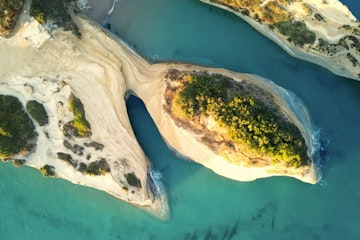
How to Get to Corfu
Corfu has been a major tourist hotspot in the Ionian part of Greece since at least the 1960s. One upshot is that it's now pretty accessible, especially when compared to other destinations in the region – Ithaka, Paxos, Antipaxos. With sea on all sides, there's really only two ways to arrive…
Corfu Flights
Breathe deep – it's the Aerolimenas Kerkiras Ioannis Kapodistrias (CFU) that's the main gateway from the air. Don't worry if you can't pronounce that, the locals call it, simply, Corfu Airport. Today, it's the fifth-busiest airport in the whole of Greece, catering to over 3.5 million passengers each year. Most come in on seasonal flights, which form 95% of the traffic arriving on the runways – only a few domestic connections to Athens run in the winter months.

Airlines that run to Corfu Airport from across Europe include:
- Ryanair – A low-cost carrier that connects Corfu to big budget hubs across Europe, most notably Bergamo, Charleroi, and Rome–Ciampino. Ryanair also offers a short-haul connection to Santorini (starting in 2021).
- Wizz Air – More low-cost connections that run seasonally, going to more premium hubs on the continent, including Milan MXP, Vienna, and Warsaw.
- EasyJet – Cheap tickets from major UK airports to Corfu, with plenty of options from London.
- Aegean Airlines – Affordable but not a low-cost carrier, Aegean Airlines now offer regular connections to Corfu (sometimes via Athens) from cities like Moscow, Munich and Paris.
Corfu Ferries
The location of Corfu right on the cusp of western Greece means that ferries come in here from both Italy and the mainland, not to mention neighbouring countries like Albania. Sadly, Corfu is a little too far west and north to be accessible by direct boat from famous island-hopping destinations in the heart of the Aegean, so you're probably looking at a flight or a bus transfer via Athens if you want to arrive from places like Santorini and Milos.
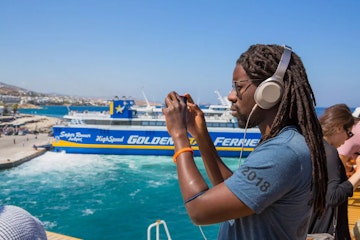
Some popular ferry links that go to Corfu include:
- Igoumenitsa to Corfu (<€10/1 hour) – The quickest way to trade the Greek mainland for the beaches of Corfu, this connection runs around six times per day in the summer months. And it's cheap, too!
- Venice to Corfu (€175/15-20 hours) – Yep, you can now enjoy the romance of Venice in the same trip as idyllic Corfu. Minoan Lines and Anek Lines both run ferries several times per week. They go across the Adriatic at night and get you into port by the early afternoon.
- Bari to Corfu (€80/6.5-10 hours) – As many as six ferries each week make the crossing from Bari in southern Italy to Corfu. Some go overnight, others run in the afternoon and arrive in time for a Greek mezze dinner on the quays of Corfu Town.
We hope this guide to Corfu has tempted you to visit the stunning zigzag of an island in the northern Ionian Sea. It's packed with pebbly beaches, mystical Orthodox monasteries, and even has a pumping nightlife scene down in Kavos. What more could you ask for?


